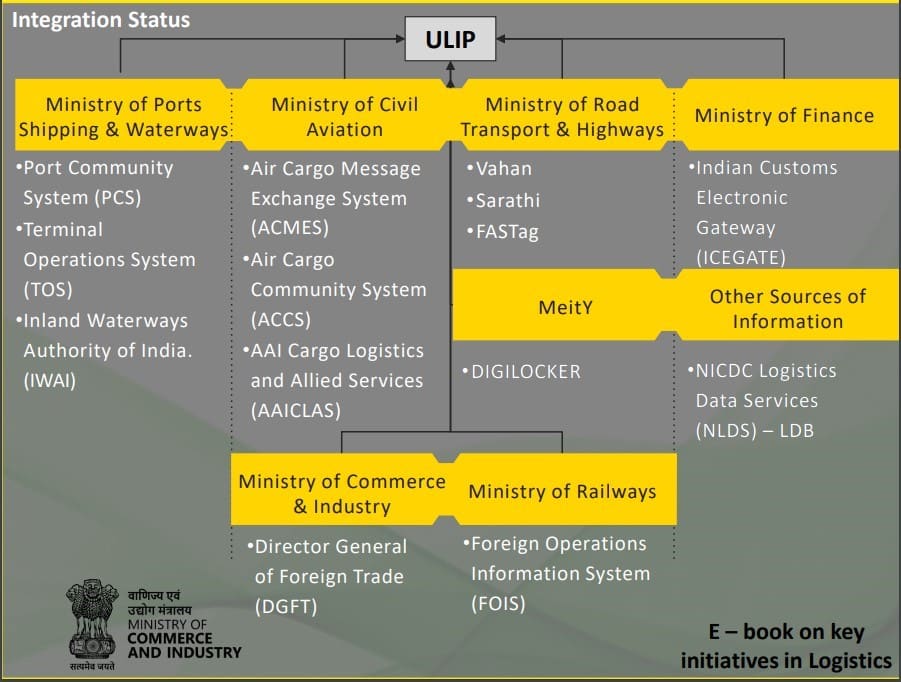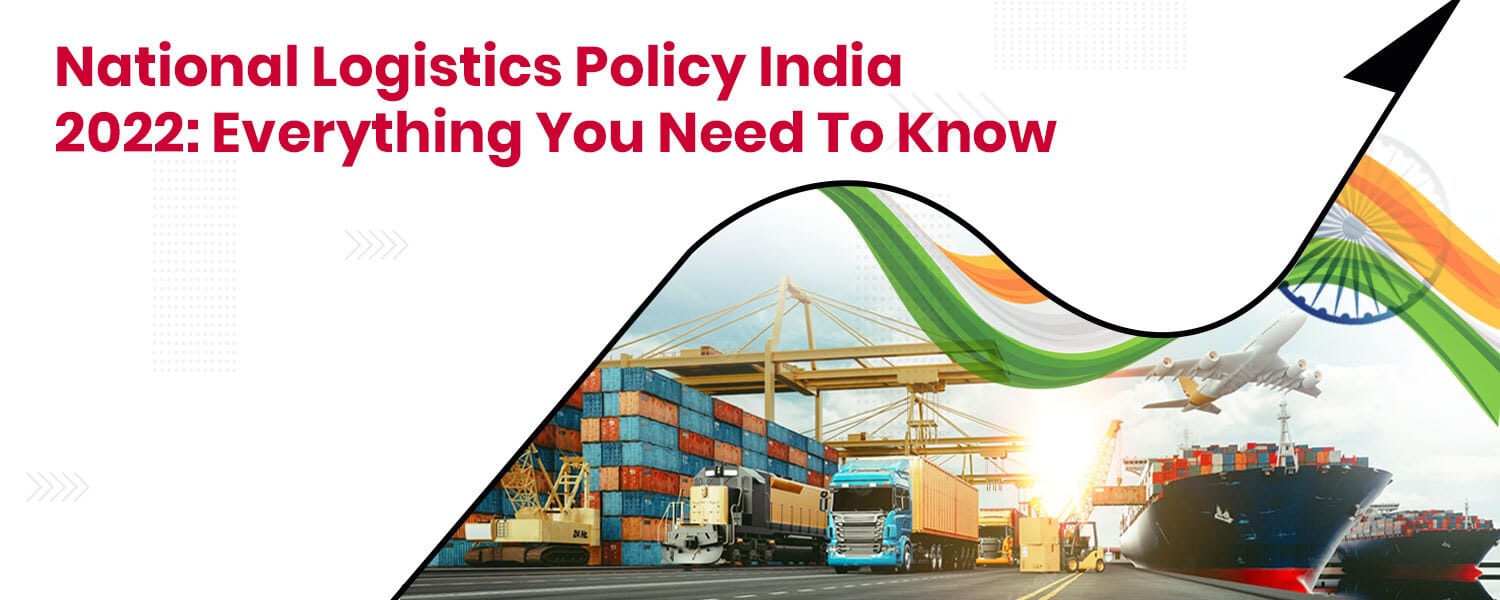Today, India is the fifth largest economy in the world, and if we ask you, what are its contributing sectors? Your mind may answer Defence, Pharma, Manufacturing, IT, or the space sector. But here you’re omitting one crucial industry that efficiently connects all of the above: logistics. As many of you eCommerce sellers understand, our logistics system is fragmented and unorganised despite being a critical pillar of the economy. Therefore, countering this inefficiency, the government of India launched The National Logistic Policy with the vision of developing a tech-enabled, resilient, and cost-efficient logistic ecosystem in the country.
Just like UPI was game-changing for the payment system, ONDC will revolutionise the Indian eCommerce Industry, and the National Logistics Policy is expected to do the same. Under this policy, the government has announced several initiatives and frameworks:
- Unified logistics interface platform
- Integration of digital system
- Ease of logistics
- System improvement group
Stay tuned; we will go down the hole and discuss these initiatives, but first, let’s acknowledge the current issues in our logistics sector.
Current Problems in the Indian Logistics Industry
India was ranked 44th in the 2018 World Bank Logistic Performance Index, depressing for a growing economy like ours. A logistic system is like a chain that consists of:
Raw Material → Supplier → Manufacturer → Distributor → Customer
And the slightest inefficiency can develop catastrophic situations, which we experienced during Covid’s second wave. Being such a crucial sector, our logistic ecosystem has various loopholes.
Redundant process and infrastructure
The current logistics infrastructure of India has too many roadblocks that slow down the process. For example, we’ve more than 20 government agencies, 37 export promotion councils, 500 certifications, and 10000 commodities. In this way, sellers spend more time getting certifications and approval from government bodies than producing and shipping products.
Highly fragmented sector
If you look at the cost of transporting per metric ton per kilometre of goods, it costs INR 18 by air, INR 3.6 by road, INR 2 by water, and INR 1.6 by rail. Being rail transportation is the most economical mode, only 17.5% of the trade is executed via rail. 71% of the transportation in India happens by road transportation. We don’t have goods trains in India, and these trains are given less line clearance than passenger trains, resulting in delays. The security via rail is so low that it has a high chance of theft and damage.
Unorganized
Road transportation is the common mode, but it is unorganised and inefficient. More than 85% of the transporters have less than 20 trucks, and it is far from digitalisation that most transport and warehousing players have low technology adaptation.
Inefficiency in multi-model transportation interconnectivity
The lack of national highways to connect different parts of the country is one of the reasons for transport delays. In addition, the inefficiency of different check posts and toll plaza negatively hit the supply chain.
Infrastructural Deficit
The current ecosystem of the logistic sector lacks the infrastructure that can interconnect north to south and east to west, hindering the supply chain. If we look at Indian ports, despite the development in recent years, our ports get crowded, which increases the container’s turnaround time and affects the country’s imports and export.
What is National Logistics Policy?
Because of the current logistics hurdles, the government is coming out with a national logistics policy. This policy will develop a multi-model system and remove the logistic sector’s obstacles with the help of re-engineering and digitisation.
The government laid the foundation of this policy in 2019, and we’ve witnessed a glimpse of it from time to time. For example, a separate logistics department was created in the Commerce Department in 2017, and the launch of the PM GatiShakti scheme– the national plan for multi-model connectivity to economic zones in 2021.
While the integrated infrastructure is envisaged to become reality through PM GatiShakti’s National Plan, the National Logistics Policy will offer a comprehensive agenda for the development of the entire logistics ecosystem, as a next step.
Targets of the National Logistics Policy
- Reduce the cost of logistics in India to be comparable to global benchmarks by 2030.
- Logistics Performance– endeavour to be among the top 25 countries by 2030.
- Create data-driven decisions to support mechanisms for an efficient logistics ecosystem.
Comprehensive Logistic Action Plan (CLAP)
The NLP will be executed through a comprehensive logistic action plan which is divided into eight key areas:
1. Integrated Digital Logistics system
Develop a system of unified logistics interface to link multiple data sources and develop cross-sectoral use cases for logistics stakeholders.
2. Standardization of physical assets & benchmarking service quality standards
Enhance interoperability, minimise handling risks, undertake process optimisation, and improve ease of business through standardisation of physical assets and benchmarking service quality standards in logistics.
3. Logistics Human Resources Development and Capacity Building
Develop an overarching logistics human resource strategy. Under its guiding principles, line ministries will develop action plans to address skill development-related and internal capacity-building challenges in the respective sector.
4. State Engagement
Provide support for the development of state/city level logistics plans, set up an institutional framework to take action at the city/state level, measure and monitor action by states and rank them.
5. EXIM (Export-Import) Logistics
EXIM (Export-Import) Logistics: Addressing infrastructure and procedural gaps in India’s EXIM connectivity and creating an efficient and reliable logistics network, with transparent and streamlined cross-border trade facilitation, for improved trade competitiveness and greater integration of India with regional and global value chains.
6. Service Improvement framework
Improving regulatory interface to enable seamlessness between sectors, promote standardization, formalization, and interoperability; eliminate fragmentation in documentation, formats, processes, and liability regimes; reduce gaps in regulatory architecture.
7. Sectoral Plan for Efficient Logistics
Sectoral Plans for Efficient Logistics (SPEL), aligned with PM GatiShakti, will be developed for each sector with underlying interoperability, resiliency, sustainability, and innovation philosophies. Specifically, SPEL would:
- Address logistics issues related to infrastructure, processes, digital improvements, policies, regulatory reforms, and capacity building for a better workforce,
- Prioritize cross-sectoral cooperation to complement and not duplicate efforts and focus on the optimisation of the modal mix.
8. Facilitation of Development of Logistics Parks
Logistics parks (e.g. Multi Modal Logistics Parks, Air Freight Stations, Inland Container Depots, Container Freight Stations, cargo terminals, etc.) are hubs for intermediary activities (storage, handling, value addition, inter-modal transfers, etc.) in the supply chain connected by a transportation network. It is envisaged to take the following steps to facilitate the development of logistics parks:
- Draft framework guidelines to facilitate the development of Logistics Parks in the country with a focus on encouraging private investment.
- Create a network of logistics parks by mapping them on the PM GatiShakti NMP for enhanced visibility, improved logistics efficiency, optimum utilization, and connectivity.
The National Logistics Policy puts the industry on the cusp of the next stage of economic growth, and it will help the last mile to be more efficient and bridge the transportation gap. It aims to reduce the logistics cost of 14% of GDP to single-digital in the next five years.
This policy will encourage the super-optimised hub-and-spoke distribution model to transport goods to different cities seamlessly. Let’s say we’ve five major cities: Pune, Hyderabad, Chennai, Kochi, and Bangalore. To connect these cities, instead of sending trucks to every other city, one of these cities is made as a hub, in this case, Bangalore, to transport the goods to every other city. Now only one truck will leave Pune and carry all the goods to be sent to Hyderabad, Chennai, and Kochi, the similar case will be with trucks coming from other different cities.
This system will unlock many advantages; you won’t need multiple trucks to carry goods to every city. By this, road transportation costs will also be reduced to a large extent.
This hub-and-spoke model will be applied to air and water transportation as well.
How Unified Logistic Interface Platform (ULIP) and Integration of Digital System will Revolutionize Logistics
The Unified Logistics Interface platform is an interface to develop a streamlined cargo movement in short distances while maintaining distance and time efficiency and all the information on cargo movement will be available confidentially on a real-time basis.
As per our Hon’ble Prime Minister, the ULIP is one of the seven initiatives under the ‘Technology Commons’ initiative that the stakeholders can effectively utilise to enhance efficiency and reduce the cost of logistics in the country.
ULIP Architecture
ULIP is an open-source platform that works on a request and response-based system that integrates multiple systems of different stakeholders. The NICD’s Logistics Data Bank Project has been used to develop it. The platform is a three-tier structure comprising:
1. Application Layer
It bridges the gap between the data source and the user of data.
2. Presentation Layer
Some major private players in the logistics sector have been invited to develop the Presentation Layer, which will be an interface with the end customer.
3. Governance Layer
The Governance Layer is to help the policymakers to take policy decisions ensuring compliance. Currently, 30 logistics systems of 07 Ministries/Departments covering over 1600 fields have been integrated through 102 APIs with ULIP.
The Integrated structure of Unified Logistic Integrated Platform

The Three Key Components Defining ULIP
1. Integration with existing data sources of ministries
Keeping in mind the gravity of authorization, compliance, and clearance in the logistics, the integration with data points of ministries will endow a comprehensive take on several interlinking activities of the system.
2. Data exchange with a private player
The ULIP will enable the private players, logistic service providers, and industries to leverage the data and, at the same time, share their data (transportation, dispatch, delivery) to the system to bring efficiency to the process.
3. Unified document reference in the supply chain
To enable a single digitised document reference number to be used for all documentation, a national logistics policy was launched in January 2012. IDS is the first step in this policy (integration of the Digital System). This system will connect 30 different systems of seven ministries (road transport, railways, aviation, customs, foreign trade, and commerce ministries).
What is Ease of Logistics (ELOG) and System Improvement Group (SIG)
E-logs, aka Ease of Logistics, is a digital portal developed by the Logistic Division, DPIIT, to enable time-bound resolution of issues. This digital platform is for registering, coordinating, and monitoring resolution for issues of users being developed on which authorised user associations will register and upload their issues.
The registration process will comprise 5 steps:
Step 1. Login to the portal.
Step 2. Add issues or suggestions with single/ multiple stakeholders.
Step 3: Add title and priority, and submit relevant documents.
Step 4: SIG (system improvement group), in consultation with the Ministry/Department, will upload the decision considering your documents.
Step 5: Resolution of the issue is shown to the concerned user.
The Service improvement group (SIG), along the lines of the Network Planning Group (NPG), was formed to coordinate and monitor the mechanism for unresolved user issues regarding services. It consists of officers nominated from ministries.
The problem that can make National Logistics Policy a Disaster
All these initiatives look like a cakewalk, the government is spending millions and billions on the development of infrastructure and streamlining the process, and everything seems hunky-dory. But before you take a breath of relief, let’s move towards the climax and discuss challenges and hurdles that, if not kept an eye on, will ruin the entire policy.
Access to the internet
Because the entire system is shifting toward digital, one major hurdle is providing uniform access to the internet connected to everyone. This includes truckers and unskilled workers who do not know how to access the internet while travelling. Adding to this, the government has to put concentrated efforts into giving everyone access to the 4G internet connection.
Political tussle
We need equal support and coordination to execute the national logistic policy efficiently. And this sometimes takes the shape of a political tussle between India’s ruling and state governments.
User issues with trust
In India, the government is infamous for its inefficiencies somehow. So the question arises, is this digital system able to give 24/7 customer support, and that too in the regional languages of unskilled workers (truck drivers, etc.)? Will the users efficiently track their shipments without any server issues?
All these challenges should be taken into account by the concerned parties in order to turn this initiative revolutionary.
Conclusion
The national logistics policy is the first step to organising the highly imperative and fragmented sector and a leap toward making a trillion-dollar economy. Through the policy, the tech-enabled solution with infrastructural development will boost the Indian logistic ecosystem and supply chain.




